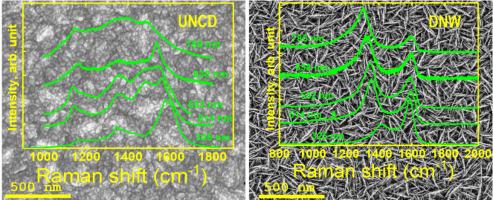用拉曼光谱研究超晶金刚石薄膜中的局域声子
IF 5.1
3区 材料科学
Q2 MATERIALS SCIENCE, COATINGS & FILMS
引用次数: 0
摘要
本研究利用拉曼光谱的多波长激发(紫外-紫外、可见光和近红外)来探测超微晶金刚石(UNCD)薄膜的共振和非共振散射机制,探索波长依赖的声子色散、缺陷激活模式和晶界的界面振动。由于与区中心光学声子的共振耦合,紫外激发增强了金刚石D*峰,而可见光和近红外光谱突出了非晶态碳(a-C)/sp2丰富的晶界贡献(D, G和反式聚乙炔(t-PA)模式)。温度相关的研究(低温到室温)证明了异常声子的行为:D和G波段由于非谐波而红移,而t-PA的v2模式由于减小的佩尔斯失真而蓝移。激光功率相关的测量揭示了热应变效应,声子模式的硬化诱导初始蓝移,随后在更高的功率下热红移。偏振分辨光谱识别晶界处的对称性破缺,由v3模式的各向异性散射证明。通过爱因斯坦和德拜模型计算,UNCD的热容量由于低能振动和缺陷模式而偏离体金刚石。本文章由计算机程序翻译,如有差异,请以英文原文为准。

Study of localized phonon in ultrananocrystalline diamond films investigated by Raman spectroscopy
The study employed multiwavelength excitation (UV-ultraviolet, visible and near infrared) of Raman spectroscopy to probe resonant and non-resonant scattering mechanisms in ultrananocrystalline diamond (UNCD) films, exploring wavelength-dependent phonon dispersion, defect-activated modes, and interfacial vibrations of grain boundaries. UV excitation enhanced the diamond D* peak due to resonant coupling with zone-center optical phonons, while visible and near infrared spectra highlighted amorphous carbon (a-C)/sp2-rich grain boundary contributions (D, G, and trans-polyacetylene (t-PA) modes). Temperature-dependent studies (cryogenic to room temperature) demonstrated anomalous phonon behavior: the D and G bands redshift due to anharmonicity, while the mode of t-PA blueshifts from reduced Peierls distortion. Laser power-dependent measurements revealed thermal strain effects, with hardening of phonon mode inducing initial blueshifts followed by thermal redshifting at higher powers. Polarization-resolved spectroscopy identifies symmetry breaking at grain boundaries, evidenced by anisotropic scattering of the mode. The heat capacity of UNCD, calculated via Einstein and Debye models, deviates from bulk diamond due to low-energy vibrational and defect modes.
求助全文
通过发布文献求助,成功后即可免费获取论文全文。
去求助
来源期刊

Diamond and Related Materials
工程技术-材料科学:综合
CiteScore
6.00
自引率
14.60%
发文量
702
审稿时长
2.1 months
期刊介绍:
DRM is a leading international journal that publishes new fundamental and applied research on all forms of diamond, the integration of diamond with other advanced materials and development of technologies exploiting diamond. The synthesis, characterization and processing of single crystal diamond, polycrystalline films, nanodiamond powders and heterostructures with other advanced materials are encouraged topics for technical and review articles. In addition to diamond, the journal publishes manuscripts on the synthesis, characterization and application of other related materials including diamond-like carbons, carbon nanotubes, graphene, and boron and carbon nitrides. Articles are sought on the chemical functionalization of diamond and related materials as well as their use in electrochemistry, energy storage and conversion, chemical and biological sensing, imaging, thermal management, photonic and quantum applications, electron emission and electronic devices.
The International Conference on Diamond and Carbon Materials has evolved into the largest and most well attended forum in the field of diamond, providing a forum to showcase the latest results in the science and technology of diamond and other carbon materials such as carbon nanotubes, graphene, and diamond-like carbon. Run annually in association with Diamond and Related Materials the conference provides junior and established researchers the opportunity to exchange the latest results ranging from fundamental physical and chemical concepts to applied research focusing on the next generation carbon-based devices.
 求助内容:
求助内容: 应助结果提醒方式:
应助结果提醒方式:


